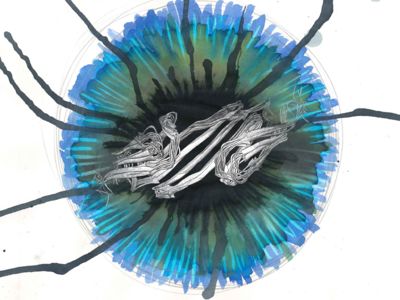Art:Focusing on Crystallin
From Proteopedia
Behind the Artwork and the Protein Structure
As you read the words on this page, the light enters your eyes and the eye lens focuses it on the retina. From here the image is sent to your brain for processing. The major protein from the eye lens is shown here, showing how crystallin proteins enable vision, but can also block it. The structure depicted is the crystallin domain dimer of alphaB crystallin solved by solid state NMR. This was solved in the context of the oligomer, and shows each monomer forming the conserved dimer. The artist who created this image is Anna Valchanova, a student at Stephen Perse School in Cambridge, UK. She has depicted the protein in front of the eye illustrating how, when aggregated, this protein can block vision. The bright, vibrant colours of the iris contrast against the dull, grey palette of the protein, reflecting the loss of vision as cataracts develop.
View in 3D or go to PDB structure 2klr [1]
AlphaB crystallin
Rather than being built of glass or plastic like the lens in a telescope, the lenses in your eyes are built of specialised cells. These cells began life like any other cell, however they produce lots of the protein alphaB crystallin, and then discard most of their cellular organelles, including mitochondria and nuclei. These organelles scatter light, and so would cause the lens to be opaque. These stripped back remains of cells, which are now clear bags of crystallin proteins, are arranged into a structure rather like the layers of an onion. Together these cells form the disk-like structure of your eye lens. As these lens cells have lost their nuclei, they cannot make fresh crystallin proteins as they've no longer got the DNA to code for them. The crystallin proteins they begin life with must therefore remain intact and functional for the life span of a human, requiring them to be very stable.
The Crystallin Domain
The structure shown to the left is the crystallin domain dimer of one of the most well studied lens proteins, alphaB crystallin. AlphaB crystallin protein is comprised of a core crystallin domain with sequence extensions at either end, the N- and C- termini. The crystallin domains dimerise and then assemble further to build large (~500 kDa) complexes, containing between 20 and 30 monomers. The domain architecture, 3D fold and oligomer formation.
Crystallins are members of the small heat shock protein family, a family which has chaperone activity. This means they are able to help proteins stay folded and remain stable. Presumably, in the eye lens, much of the chaperone activity is on the crystallins themselves, making sure that these proteins stay soluble and in shape for years.
Why do Cataracts Form in Old Age? A Cloud of Mystery
In spite of the chaperone activity, with age, the proteins in the eye lens begin to lose their stability and solubility, clumping together in non-soluble aggregates. The aggregates scatter light rather than focusing it, and your lens becomes cloudy. This is termed a cataract. While some factors, such as diabetes, make you more susceptible to cataracts, the exact steps of the process by which a cataract is formed are not well understood. One eye of a person, and not the other, can get a cataract. You would expect both environmental and genetic factors within the two eyes to be essentially the same, but evidently this is not quite so. Once formed, only an operation can restore your vision as there are no drugs to reverse the aggregation process of cataract formation. The operation involves a surgeon removing the cloudy lens and inserting a synthetic one.
Explore the scientific publication
- ↑ Jehle S, Rajagopal P, Bardiaux B, Markovic S, Kuhne R, Stout JR, Higman VA, Klevit RE, van Rossum BJ, Oschkinat H. Solid-state NMR and SAXS studies provide a structural basis for the activation of alphaB-crystallin oligomers. Nat Struct Mol Biol. 2010 Sep;17(9):1037-42. Epub 2010 Aug 29. PMID:20802487 doi:10.1038/nsmb.1891

